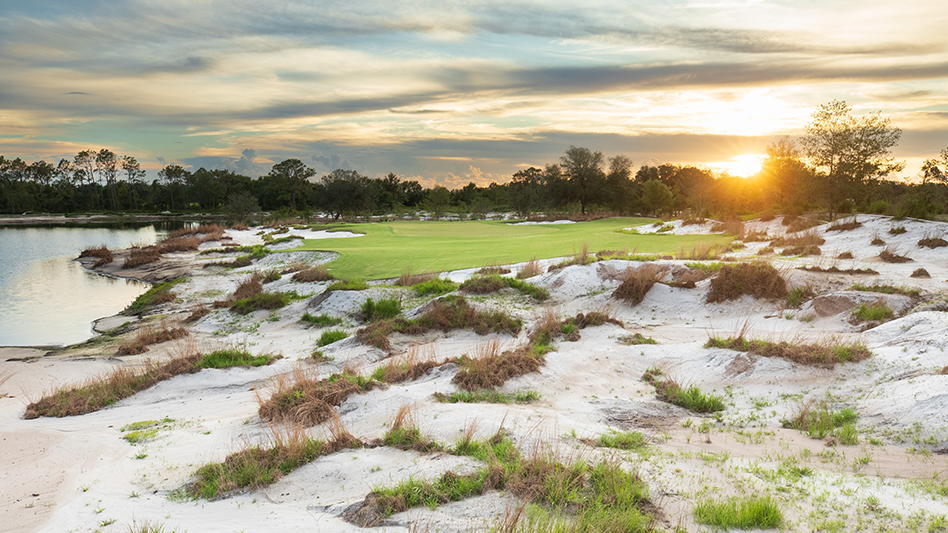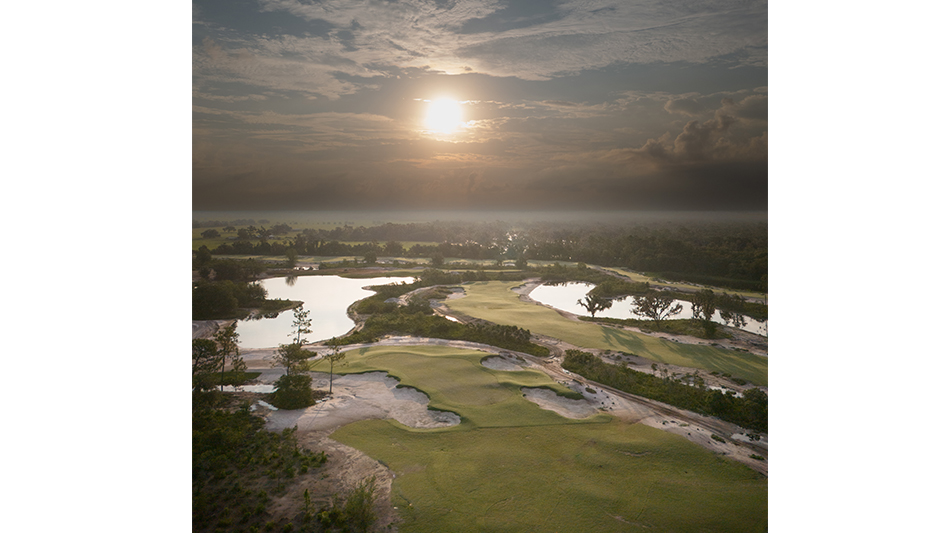
Wayne Branthwaite (3)
Three years ago, Miakka City was your prototypical Florida cow town, a place where the bovine residents outnumbered humans 7 to 1. Cows don’t need a downtown, so there wasn’t one. Not even a blinking light. Just an intersection located 35 minutes east of Sarasota on Highway 70.
Today, cows still represent an impressive majority, but a pair of new private clubs have closed the gap. The first, Soleta Golf Club, opened in November — just 11 months after Heritage Links broke ground on a layout from Nick Price Golf Course Design. The second, Miakka Golf Club, is scheduled to debut in 2025.
The two projects have much in common. Each development group was attracted by golf’s most prized commodity these days: pure white sand, in nearly unlimited supply. Heritage Links, a division of Lexicon, Inc., is another commonality. While the Houston-based contractor built Soleta all on its own, it remains one of five different companies participating in the construction of Miakka Golf Club.
That’s where the similarities end. Soleta is a traditional private club with a housing component, where Miakka was conceived as a single-owner project. What’s more, Soleta took shape on a distinct, low-profile model that called for moving just 1.2 million cubic yards of dirt. The fact that the design and construction teams called it good at 900,000 indicates just how seriously all parties took the model. Heritage finished the job $2 million under budget, validating the whole shootin’ match.
“Those realities were not at all budget-driven,” says Wayne Branthwaite, vice president of Jupiter, Florida-based Nick Price Golf Course Design. “We were determined to keep the natural feeling, the vegetation. I told our owner: If we had another 10 million to spend out here, we wouldn’t know where to spend it.”
The concept from Day 1 at Soleta was different, explains Heritage Links project manager Jorge Huerta, a veteran of more than two dozen new builds and renovations in the state of Florida. “For example, Nick didn’t want the typical Florida course with water lining every green and fairway. You can see some water on this course, but it’s not typically in play. Nick believes staying close to the natural grade does create this intimate relationship to the native terrain and vegetation — if you can drain it.
“The Miakka River runs next to No. 5 green — 10 feet below the lowest golf course elevation. The design cleverly uses the native areas to move water naturally, as it historically did. The 12 lakes we built cascade from the top of this property down to the exit, near the river. Engineering did a great job linking all the storm-drainage structures to the wetland system running through the project.”
Before Heritage Links became attached to the project, Price and Branthwaite had already begun the design process — on behalf of an ownership consortium led by Sarasota resident Charles Duff. They spent a long time on site scouting and studying this terrain in order to create a master plan for Soleta, in addition to the golf course layout.
This sort of deliberation enabled two extraordinary bits of good fortune.

The first: Hurricane Ian, which rocked the West Coast of Florida in September 2022. “Of course, the Miakka River came up and flooded part of the property quite severely,” recalls Branthwaite, a former golf course superintendent who cut his design teeth with Gary Player’s firm. “That event was closely followed by a tropical storm that caused the river to rise even further, well above the 100-year flood elevation. As a result, we had a very clear idea of where the golf course should go and what the minimum grades should be.
“We went on to develop a very detailed routing and design. From the early days of walking the property, we had a concept about how it would look — but nothing set in stone. Nick and I were determined to let that evolve as we shaped the early holes. It’s such an interesting environment: white sand with lots of native palmettos, scrub pine, blue sedge and broom sedge — all of which the owner was happy to relocate and reincorporate back into the course later. Moving all the lakes to the side meant the design could retain as much of the native vegetation between holes as possible.
“With all these natural elements on site,” Branthwaite adds, “we were determined to allow the native sand, vegetation and grasses to define the golf course. How that was going to be done exactly? Well, that evolved.”
The evolution of Soleta actually began well before Hurricane Ian, back in 2008, when the Great Recession put the brakes on course development across North America. Huerta had been working as a project manager for Weitz Golf, which, like course contractors across the industry, quickly started shedding staff.
“Wayne Branthwaite was working with Nick Price by then and he was looking for a project manager to run this job in Playa del Carmen, down in the Yucatan,” Heurta remembers. “Wayne talked to Jon O’Donnell [president of Heritage Links], who I’ve known since 1991. Jon made the connection and off I went to Mexico. Six months later, Wayne brings in Dean Bedwell as a shaper. “And that’s basically the design and construction team for Soleta, right there.”
“Projects are hard,” Branthwaite adds, “but I’m convinced that if you put the right people in place and allow them to collaborate — to have a stake in the process — projects become easier, as everyone then pulls in the same direction.”
Post-Yucatan, Huerta joined Heritage Links, where he quickly became the firm’s go-to project manager for Florida. It was an easy decision to reach out to Huerta and Heritage for this project, according to Branthwaite. In wake of Hurricane Ian, Branthwaite and Huerta got to work on Soleta’s construction plan and budget while permits were established.
“As we got closer to a start date, Wayne and Nick needed someone to bring their concept to life,” Huerta says. “Their design plan gave a solid depiction of what they envisioned on the ground. We needed someone to wear a creative hat, someone to put the drama into the golf course — to lay the plan over the natural terrain, if you know what I mean.”
Huerta and Branthwaite agreed Bedwell would be the best fit, the final piece of the puzzle. But Bedwell was engaged elsewhere.
Then came the second piece of good fortune.
“At that point, I was already working a big project on East Coast of Florida,” Bedwell says. “Unfortunately, things went a certain way, and I had to leave. Jorge is kind of my mentor, so I called him to let him know I was making a change. He caught me up on what they were planning at Soleta. But all the positions were filled, and I already had feelers out about other work. I guess Jorge made some phone calls. Five minutes after I hung up with him, Wayne called and said, ‘You’re coming to work for us.’ A lot of this business is who you know, but in the end, it’s more about timing.”
“It took maybe five breakfasts to close the deal,” Huerta says. “Once we had that deal, we just kept meeting for breakfast — over the next 11 months of construction.”
As a course-construction professional, Huerta is clearly enamored of just how quickly and efficiently Soleta came to fruition, once ground was broken. The site had a lot to do with that. Sand is easy and relatively cheap to manipulate. These conditions also allowed the look of Soleta to reveal itself. In an arboreal forest, on clay soils, the same sort of aesthetic evolution might take years — and cost the owner a small fortune.
Still, Branthwaite, whose design firm had never worked with Heritage Links, appreciates the collaboration Soleta’s site and contractor made possible.
“That is what you set out to do: to build a golf course for X amount of money in a certain amount of time,” he says. “But the success of the golf course is still measured by the owner, by his members. To accomplish all those things, you have to be reasonable. For example, as an architect, I’m not going to give up the look and style and playability of the golf course just so we can get it done three weeks earlier. There must be give and take.
“That was the beauty of this project. We had all worked together before, and it was easy to work with Jon O’Donnell, whom I’ve known for many years. Heritage has done so much fantastic work. Having the backing and resources of Lexicon makes it so much easier, and reassuring, to bring them to the table.”
Bedwell has been around several blocks since 2008, but he’d not worked a Price-designed job since Playa del Carmen. “At Soleta, it was an easy transition back to working with Nick. He has a strategic vision for every hole. He wanted this course to be accessible to everyone. Anyone can make a course long and difficult. But forced carries, for example, just make the game too complicated for average players. Nick says the ball travels through the air, but golf is played on the ground. He’s right.
“So, we were very conscious of bunker positions. We made sure the angles were always there for average player — even angles from the native sand. From the forward tees back to the member tees, there are no big carries over sand. Zero. And, of course, there’s no water out there in the line of play, except directly in front of a couple tees.”

It's interesting to hear a shaper talk about a particular design where he has obviously enjoyed a great deal of input.
- On the decision to go roughless at Soleta: “Designers have started to do this, and I’m on board,” Bedwell told me in October, from the cab of his Cat D3 dozer. “When grass is shorter, your micro-contouring is more visible. You don’t quite get that impression from the tee, but as you get closer, you do see all that detail. It adds interest.”
- On the art of chunking: “Our contrast at Soleta is this beautiful white sand. And we wanted those native areas playable. Depending on the anticipated traffic, we just plugged in the broomsedge and blue sedge, which grows in these fields all around the property. So, it was selective chunking scattered about, right up to the fairway edges — sporadically, like it was out there naturally, but a bit more concentrated in the duney areas where we needed erosion control.”
- On playing downhill (in Florida): “Our concept was not completely low profile. Instead of making a fill that was 15 feet, we’d do six to eight. Tees are generally five or six feet above native terrain. Still, we were able to create some really great downhill feels out there, which is hard to do in South Florida. For the golfer, No. 5 feels almost like a true, downhill par 5 — because 4 to 5 feet is actually quite a bit when you look down at a green from your first or second landing area. At No. 8, another par 5, we just filled — about 14 feet in that first landing area. That’s as big as we went anywhere on the course. The clubhouse is 15 feet. Same for the tees at 17.”
Bedwell, Huerta and Branthwaite handed the keys to Soleta course superintendent Clay Batson in early November, after two more tropical storms battered the west coast of Florida in October. The course opening was delayed a few weeks, to the end of November, on account of clean-up.
Otherwise, all systems are go. At some point in 2025, this cow town will have yet another new course.
“We are not in competition with Miakka GC, and Heritage is involved in the project — so I can say that without judgment,” Huerta explains. “But Soleta turned out very special.”
Hal Phillips is a Maine-based freelance writer, managing director of Mandarin Media, Inc., and former editor-in-chief of Golf Course News.
Latest from Golf Course Industry
- From the publisher’s pen: Conscientious of a bigger role
- Bernhard and Company partners with Laguna Golf Phuket
- Terre Blanche showcases environmental stewardship
- VIDEO: Introducing our December issue
- Bernhard and Company introduces Soil Scout
- Nu-Pipe donates to GCSAA Foundation’s Centennial Campaign
- GCSAA enhances golf course BMP tool
- Melrose leadership programs sending 18 to 2026 GCSAA Conference and Trade Show





